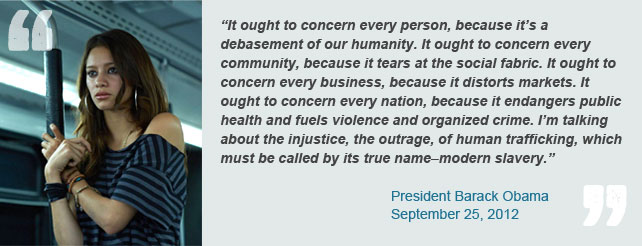The Problem
The extent of the problem
Human trafficking is modern-day slavery, a type of injustice that violates basic human rights. Initially viewed as a victimless crime, it is now recognized as multiple types of long-term involuntary servitude for purposes of providing sex or labor, forced upon a defenseless individual, usually a woman or child, using fraud, force, and/or coercion. The term “trafficking” is deceptive because a person need not be transported to another location in order to become a victim of human trafficking.

A background on human trafficking
Human trafficking is one of the fastest growing criminal industries in the world, attracting transnational and domestic criminal organizations because it is becoming more financially lucrative in many cases than the international drug trade or other illegal activities. Several billion dollars per year are generated by victimizing millions of people around the world. It is especially contemptible and inhumane because it inflicts harm upon another human being–stealing their dignity, causing bodily injury, and taking away their freedom–for the sole purpose of the financial gain of criminals.
Social scientists estimate that globally, as many as 27 million men, women, and children are victims of human trafficking at any one time, but only 40,000 victims were identified last year. This is a crime that occurs in the shadows, out of the view and reach of law enforcement. Human traffickers prey on the poor, the homeless, ethnic minorities and indigenous groups, migrant workers, undocumented immigrants, persons with disabilities, and other marginalized populations reluctant to seek assistance from the government or other organizations.
The U.S. is one of the top destination countries for human trafficking, and California is one of the four top destination states in the country. Human traffickers are becoming increasingly sophisticated and organized. New tools, such as social media, are making it easier to attract potential victims, facilitate the crime, and evade law enforcement. Despite the best efforts of federal, state, and local law enforcement and other government agencies, nonprofit organizations providing services to victims and their families, faith-based organizations, and concerned families and grassroots organizations, human trafficking has increased significantly in California since 2007, and the total number of victims is increasing.
Typical human trafficking scenarios
Human traffickers forcibly take total control of every aspect of the victim’s life, maintaining control over their victims through violence and coercion. Victims are subject to continuing, severe psychological and physical abuse of many types at the hands of those who hold them hostage, and believe that the outside world does not see them, or does not care about them. Traffickers control their victims by instilling fear in them as well as gratitude for being allowed to live, and encourage their victims to believe that they cannot trust anyone except the trafficker, especially persons in positions of authority such as law enforcement and health professionals.
Typical scenarios
-
Imprisonment in buildings with locked doors and windows, and/or surrounded by high fences
-
Deprivation of basic necessities such as safe, sanitary living conditions, food and sleep, and necessary medical care
-
Threats of violence, or actually inflicting physical harm from beatings, rape or gang rape, or other acts of violence
-
Threats of harm to the victim’s family, or that the victim’s family will be told about shameful activities in which the victim is involved
-
Withholding pay or making false promises of future pay for work already done
-
Subjecting victims to debt bondage by charging them burdensome up-front fees for job placement, or contracting with victims for services such as illegally transporting them across international borders, in exchange for impossibly-high or continually increasing fees
-
Threatening victims who are in the country illegally with arrest or deportation
-
Manipulating victims’ psychological vulnerabilities and physical disabilities
-
Encouraging or forcing them to use drugs, or feeding existing drug dependencies.
Victims feel a sense of grief, shame, and self-hatred, and suffer from disorders such as insomnia, eating disorders, post-traumatic stress disorder, and even attempted suicide. In addition, victims are at high risk for injuries associated with physical abuse such as broken bones and concussions, burns, and injuries to internal organs, traumatic brain injury, sexually transmitted diseases as well as other diseases such as tuberculosis, hepatitis, or pneumonia, diseases associated with malnutrition, forced or coerced abortions or miscarriages, and sterility.
For more information
Additional insight into the problem can be found at these links.
Orange County Human Trafficking Task Force
California Attorney General’s Human Trafficking Home Page
